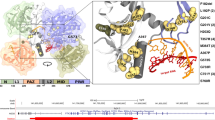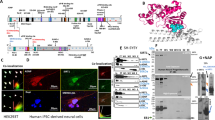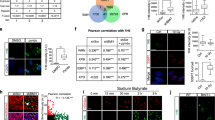Abstract
Dominant mutations in the MORC2 gene have recently been shown to cause axonal Charcot–Marie–Tooth (CMT) disease, but the cellular function of MORC2 is poorly understood. Here, through a genome-wide CRISPR–Cas9-mediated forward genetic screen, we identified MORC2 as an essential gene required for epigenetic silencing by the HUSH complex. HUSH recruits MORC2 to target sites in heterochromatin. We exploited a new method, differential viral accessibility (DIVA), to show that loss of MORC2 results in chromatin decompaction at these target loci, which is concomitant with a loss of H3K9me3 deposition and transcriptional derepression. The ATPase activity of MORC2 is critical for HUSH-mediated silencing, and the most common alteration affecting the ATPase domain in CMT patients (p.Arg252Trp) hyperactivates HUSH-mediated repression in neuronal cells. These data define a critical role for MORC2 in epigenetic silencing by the HUSH complex and provide a mechanistic basis underpinning the role of MORC2 mutations in CMT disease.
This is a preview of subscription content, access via your institution
Access options
Access Nature and 54 other Nature Portfolio journals
Get Nature+, our best-value online-access subscription
$29.99 / 30 days
cancel any time
Subscribe to this journal
Receive 12 print issues and online access
$209.00 per year
only $17.42 per issue
Buy this article
- Purchase on Springer Link
- Instant access to full article PDF
Prices may be subject to local taxes which are calculated during checkout






Similar content being viewed by others
Accession codes
References
Wang, J., Lawry, S.T., Cohen, A.L. & Jia, S. Chromosome boundary elements and regulation of heterochromatin spreading. Cell. Mol. Life Sci. 71, 4841–4852 (2014).
Margueron, R. & Reinberg, D. The Polycomb complex PRC2 and its mark in life. Nature 469, 343–349 (2011).
Becker, J.S., Nicetto, D. & Zaret, K.S. H3K9me3-dependent heterochromatin: barrier to cell fate changes. Trends Genet. 32, 29–41 (2016).
Talbert, P.B. & Henikoff, S. Spreading of silent chromatin: inaction at a distance. Nat. Rev. Genet. 7, 793–803 (2006).
Schotta, G., Ebert, A., Dorn, R. & Reuter, G. Position-effect variegation and the genetic dissection of chromatin regulation in Drosophila. Semin. Cell Dev. Biol. 14, 67–75 (2003).
Akhtar, W. et al. Chromatin position effects assayed by thousands of reporters integrated in parallel. Cell 154, 914–927 (2013).
Kotecki, M., Reddy, P.S. & Cochran, B.H. Isolation and characterization of a near-haploid human cell line. Exp. Cell Res. 252, 273–280 (1999).
Carette, J.E. et al. Haploid genetic screens in human cells identify host factors used by pathogens. Science 326, 1231–1235 (2009).
Tchasovnikarova, I.A. et al. Epigenetic silencing by the HUSH complex mediates position-effect variegation in human cells. Science 348, 1481–1485 (2015).
Schultz, D.C., Ayyanathan, K., Negorev, D., Maul, G.G. & Rauscher, F.J. III. SETDB1: a novel KAP-1-associated histone H3, lysine 9-specific methyltransferase that contributes to HP1-mediated silencing of euchromatic genes by KRAB zinc-finger proteins. Genes Dev. 16, 919–932 (2002).
Kokura, K., Sun, L., Bedford, M.T. & Fang, J. Methyl-H3K9-binding protein MPP8 mediates E-cadherin gene silencing and promotes tumour cell motility and invasion. EMBO J. 29, 3673–3687 (2010).
Harten, S.K. et al. The first mouse mutants of D14Abb1e (Fam208a) show that it is critical for early development. Mamm. Genome 25, 293–303 (2014).
Soehn, A.S. et al. Periphilin is strongly expressed in the murine nervous system and is indispensable for murine development. Genesis 47, 697–707 (2009).
Timms, R.T. et al. Genetic dissection of mammalian ERAD through comparative haploid and CRISPR forward genetic screens. Nat. Commun. 7, 11786 (2016).
Timms, R.T., Tchasovnikarova, I.A., Antrobus, R., Dougan, G. & Lehner, P.J. ATF7IP-mediated stabilization of the histone methyltransferase setdb1 is essential for heterochromatin formation by the HUSH complex. Cell Rep. 17, 653–659 (2016).
Wang, T., Wei, J.J., Sabatini, D.M. & Lander, E.S. Genetic screens in human cells using the CRISPR-Cas9 system. Science 343, 80–84 (2014).
Shalem, O. et al. Genome-scale CRISPR-Cas9 knockout screening in human cells. Science 343, 84–87 (2014).
Sanjana, N.E., Shalem, O. & Zhang, F. Improved vectors and genome-wide libraries for CRISPR screening. Nat. Methods 11, 783–784 (2014).
Li, D.-Q., Nair, S.S. & Kumar, R. The MORC family: new epigenetic regulators of transcription and DNA damage response. Epigenetics 8, 685–693 (2013).
Moissiard, G. et al. MORC family ATPases required for heterochromatin condensation and gene silencing. Science 336, 1448–1451 (2012).
Pastor, W.A. et al. MORC1 represses transposable elements in the mouse male germline. Nat. Commun. 5, 5795 (2014).
Liu, Y. et al. Family-wide characterization of histone binding abilities of human CW domain-containing proteins. J. Biol. Chem. 291, 9000–9013 (2016).
Liu, Y. et al. Structure and function of CW domain containing proteins. Curr. Protein Pept. Sci. 17, 497–506 (2016).
Li, S. et al. Mouse MORC3 is a GHKL ATPase that localizes to H3K4me3 marked chromatin. Proc. Natl. Acad. Sci. USA 113, E5108–E5116 (2016).
Li, D.-Q. et al. MORC2 signaling integrates phosphorylation-dependent, ATPase-coupled chromatin remodeling during the DNA damage response. Cell Rep. 2, 1657–1669 (2012).
Buenrostro, J.D., Giresi, P.G., Zaba, L.C., Chang, H.Y. & Greenleaf, W.J. Transposition of native chromatin for fast and sensitive epigenomic profiling of open chromatin, DNA-binding proteins and nucleosome position. Nat. Methods 10, 1213–1218 (2013).
Wu, J. et al. The landscape of accessible chromatin in mammalian preimplantation embryos. Nature 534, 652–657 (2016).
Kvaratskhelia, M., Sharma, A., Larue, R.C., Serrao, E. & Engelman, A. Molecular mechanisms of retroviral integration site selection. Nucleic Acids Res. 42, 10209–10225 (2014).
Sevilla, T. et al. Mutations in the MORC2 gene cause axonal Charcot-Marie-Tooth disease. Brain 139, 62–72 (2016).
Albulym, O.M. et al. MORC2 mutations cause axonal Charcot-Marie-Tooth disease with pyramidal signs. Ann. Neurol. 79, 419–427 (2016).
Laššuthová, P. et al. Severe axonal Charcot-Marie-Tooth disease with proximal weakness caused by de novo mutation in the MORC2 gene. Brain 139, e26 (2016).
Hyun, Y.S., Hong, Y.B., Choi, B.O. & Chung, K.W. Clinico-genetics in Korean Charcot-Marie-Tooth disease type 2Z with MORC2 mutations. Brain 139, e40 (2016).
Zhao, X. et al. MORC2 mutations in a cohort of Chinese patients with Charcot-Marie-Tooth disease type 2. Brain 139, e56 (2016).
Wang, T. et al. Identification and characterization of essential genes in the human genome. Science 350, 1096–101 (2015).
Doench, J.G. et al. Optimized sgRNA design to maximize activity and minimize off-target effects of CRISPR-Cas9. Nat. Biotechnol. 34, 184–191 (2016).
Horlbeck, M.A. et al. Compact and highly active next-generation libraries for CRISPR-mediated gene repression and activation. eLife 5, e19760 (2016).
Francis, N.J., Kingston, R.E. & Woodcock, C.L. Chromatin compaction by a polycomb group protein complex. Science 306, 1574–1577 (2004).
Grau, D.J. et al. Compaction of chromatin by diverse Polycomb group proteins requires localized regions of high charge. Genes Dev. 25, 2210–2221 (2011).
Clapier, C.R. & Cairns, B.R. The biology of chromatin remodeling complexes. Annu. Rev. Biochem. 78, 273–304 (2009).
Zhang, Y., LeRoy, G., Seelig, H.P., Lane, W.S. & Reinberg, D. The dermatomyositis-specific autoantigen Mi2 is a component of a complex containing histone deacetylase and nucleosome remodeling activities. Cell 95, 279–289 (1998).
Schottmann, G., Wagner, C., Seifert, F., Stenzel, W. & Schuelke, M. MORC2 mutation causes severe spinal muscular atrophy-phenotype, cerebellar atrophy, and diaphragmatic paralysis. Brain 139, e70 (2016).
Stebbins, C.E. et al. Crystal structure of an Hsp90-geldanamycin complex: targeting of a protein chaperone by an antitumor agent. Cell 89, 239–250 (1997).
Sharma, S.V., Agatsuma, T. & Nakano, H. Targeting of the protein chaperone, HSP90, by the transformation suppressing agent, radicicol. Oncogene 16, 2639–2645 (1998).
Chen, K. et al. Genome-wide binding and mechanistic analyses of Smchd1-mediated epigenetic regulation. Proc. Natl. Acad. Sci. USA 112, E3535–E3544 (2015).
Ran, F.A. et al. Genome engineering using the CRISPR-Cas9 system. Nat. Protoc. 8, 2281–2308 (2013).
Koike-Yusa, H., Li, Y., Tan, E.-P., Velasco-Herrera, Mdel.C. & Yusa, K. Genome-wide recessive genetic screening in mammalian cells with a lentiviral CRISPR-guide RNA library. Nat. Biotechnol. 32, 267–273 (2014).
Lerdrup, M., Johansen, J.V., Agrawal-Singh, S. & Hansen, K. An interactive environment for agile analysis and visualization of ChIP-sequencing data. Nat. Struct. Mol. Biol. 23, 349–357 (2016).
Acknowledgements
We are indebted to CIMR core facilities: R. Schulte and his team for FACS, and M. Gratian and M. Bowen for microscopy. We thank S. Andrews for assistance with data analysis with SeqMonk, and S. Kundu and M. Tolstorukov for helpful discussions. We thank B. Cochran (Tufts University), F. Randow (MRC-LMB), D. Rubinsztein (CIMR) and M. Brenner (Harvard Medical School) for providing materials. This work was supported by the Wellcome Trust, through a Principal Research Fellowship to P.J.L. (101835/Z/13/Z), a Senior Research Fellowship to Y.M. (101908/Z/13/Z), a Sir Henry Wellcome Postdoctoral Fellowship to R.T.T. (201387/Z/16/Z) and a PhD studentship to I.A.T., and by the BBSRC, through a Future Leader Fellowship to C.H.D. I.A.T. is supported as a Damon Runyon Fellow by the Damon Runyon Cancer Research Foundation (DRG-2277-16). The CIMR is in receipt of a Wellcome Trust strategic award.
Author information
Authors and Affiliations
Contributions
I.A.T., R.T.T. and P.J.L. conceived the study. Except for the in vitro expression and purification experiments, which were carried out by C.H.D., I.A.T. and R.T.T. performed all of the experiments and, together with Y.M. and P.J.L., analyzed the data and wrote the manuscript. G.D., R.C.R. and R.E.K. contributed essential reagents.
Corresponding author
Ethics declarations
Competing interests
The authors declare no competing financial interests.
Supplementary information
Supplementary Text and Figures
Supplementary Figures 1–10. (PDF 2738 kb)
Supplementary Table 1
Composition of MORC2 mutants. (XLSX 10 kb)
Supplementary Table 2
Full DIVA data quantifying viral accessibility across all genomic loci in wild-type versus MORC2 knockout HeLa cells. (XLSX 24640 kb)
Supplementary Table 3
Oligonucleotide sequences. (XLSX 11 kb)
Rights and permissions
About this article
Cite this article
Tchasovnikarova, I., Timms, R., Douse, C. et al. Hyperactivation of HUSH complex function by Charcot–Marie–Tooth disease mutation in MORC2. Nat Genet 49, 1035–1044 (2017). https://doi.org/10.1038/ng.3878
Received:
Accepted:
Published:
Issue Date:
DOI: https://doi.org/10.1038/ng.3878
This article is cited by
-
Keep quiet: the HUSH complex in transcriptional silencing and disease
Nature Structural & Molecular Biology (2024)
-
Nuclear mRNA decay: regulatory networks that control gene expression
Nature Reviews Genetics (2024)
-
MORC proteins regulate transcription factor binding by mediating chromatin compaction in active chromatin regions
Genome Biology (2023)
-
O-GlcNAcylation of MORC2 at threonine 556 by OGT couples TGF-β signaling to breast cancer progression
Cell Death & Differentiation (2022)
-
TASOR epigenetic repressor cooperates with a CNOT1 RNA degradation pathway to repress HIV
Nature Communications (2022)



